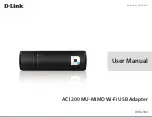
XStream
‐
PKG
‐
T™
Telephone
RF
Modem
–
Product
Manual
v5.x00
[2006.02.24]
1.3.
External Interface
1.3.1.
Front and Back Views
1-02a. RJ-11 Connector
Figure
1
‐
02.
Front
View
Standard RJ-11 connector is used to connect to telephone lines. [Pin
descriptions are on page 8]
1-02b. DB-9 Serial Port
Standard female DB-9 (RS-232) DCE connector is primarily used as
a medium to configure RF module and Telephone module
parameter values.
1-02c. Power Connector
7-28 VDC Power, Center positive, 5.5/2.1 mm Connector –
Installing internal jumpers J1 & J5 allows the unit to be powered
with a regulated 5V supply.
1
‐
02b.
DB
‐
9
Serial
Port
1
‐
02a.
RJ
‐
11
Connector
1
‐
02c.
Power
1-03a. DIP Switch
DIP Switch provides external control of speaker and
functions.
Figure
1
‐
03.
Back
View
1-03b. Config (Configuration) Switch
Configuration Switch provides an alternate way to enter AT
Command Mode. To enter AT Command Mode at the RF Modem’s
default baud rate, read the Reset Switch entry [Figure 1-03c].
1
‐
03g.
LED
1
‐
03d.
Antenna
Port
©
2006
MaxStream,
Inc.,
Confidential
and
Proprietary
6
1-03c. Reset Switch
1
‐
03c.
Reset
Switch
1
‐
03f.
RSSI
LEDs
Reset Switch forces both the Telephone Module and the RF Module
into reset (or re-boot).
1
‐
03e.
I/O
&
Power
LEDs
1
‐
03b.
Config
Switch
This switch can also be used in conjunction with the Config Switch
[Figure 1-03b] to enter the RF Module into AT Command Mode.
To enter the RF module into AT Command Mode:
(
i.
) Simultaneously press the Reset and Config switches,
(
ii.
) release the Reset Switch, (
iii.
) then after 1 sec. release the
Config Switch. The RF modem then enters AT Command Mode at
the module’s default baud rate.
1
‐
03a.
DIP
Switch
1-03d. Antenna Port
50
Ω
RF signal connector for connecting to external antenna - Antenna connector type is RPSMA (Reverse Polarity SMA).
1-03e, 1-03f, & 1-03g. LED Indicators
Table
1
‐
02.
LED
indicators
and
their
meanings
1-03e. I/O & Power LEDs
1-03f. RSSI LEDs
1-03g.
(Data Carrier Detect) LED
LED indicators visualize diagnostic status information.
The RF Modem’s status is represented as follows:
Yellow (top LED) = Serial Data Out (to host)
Green (middle) = Serial Data In (from host)
Red (bottom) = Power/TX Indicator
(Red light is on when powered,
off briefly during RF transmission)
Used to determine RSSI (Received Signal Strength Indicator)
and fade margin available in the wireless link:
3 Green LEDs ON = Very Strong (> 30 dB fade margin)
2 Green LEDs ON
= Strong (> 20 dB fade margin)
1 Green LED ON
= Moderate (> 10 dB fade margin)
0 Green LED ON
= Weak (< 10 dB fade margin)
Fade Margin = The difference between the incoming signal
strength and the modem’s receiver sensitivity.
Illuminated yellow LED indicates telephone
connection is established and
(Data Carrier
Detect) is asserted.
This signal is controlled by the Telephone
Module.







































